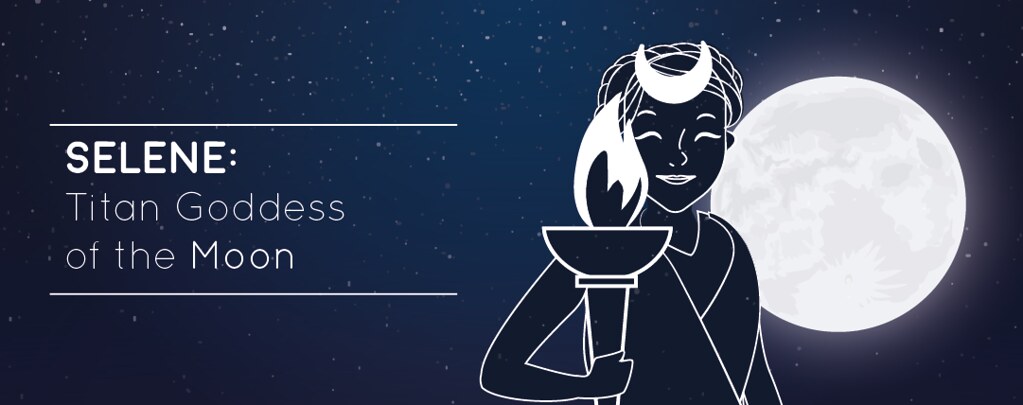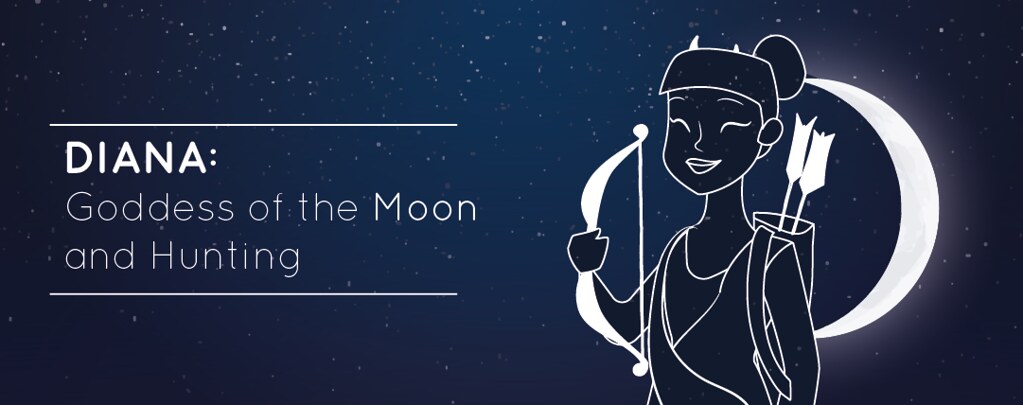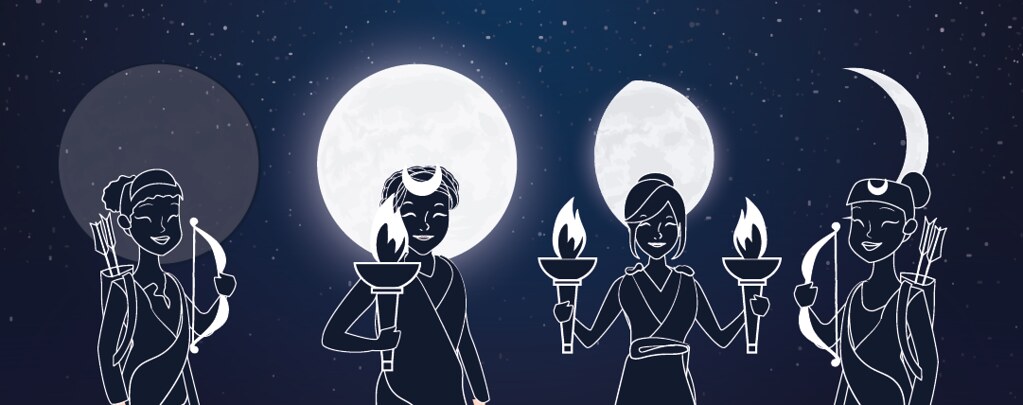The Moon and Theology: The Lunar Goddesses That Started it All
The moon has had many myths surrounding it since the beginning of time. It’s been widely held that a full moon will make humans crazy, that this lustrous orb in the sky could bring about the birth of a baby or have a hold over a woman’s fertility, or that its looming presence may make it hard to sleep at night.
It’s only fitting that such a divine and demanding force of nature is surrounded too by gods and goddesses in ancient mythology, each signifying different powers and traits, acting as symbols to be highly regarded and worshipped across religions and cultures. Today, we explore some of the most famous of these lunar deities and goddesses, delving into their individual legends and what moon phases they align most closely with.
Selene: Titan Goddess of the Moon

In ancient Greek mythology, Selene, is the goddess of the moon and a Titan goddess. Titans are divine creatures believed to precede the Olympian gods and goddesses.
This goddess was regarded as the moon itself, being the one to drive the moon chariot. Her vehicle was powered by beautiful white horses, leading her across the sky and providing those below her light each and every night. Imagine what a beautiful illusion this goddess coerces through that picturesque and divine scene!
Greek mythology says that Selene watched Endymion from the sky each night as he slept beside his cattle. Endymion was a mortal man loved by goddesses. Some legends even state that Selene and Endymion shared 50 daughters! To counter this legend, others believed that Selene had an affair with the all-powerful Greek god Zeus, even sharing several children. Legend further states that Zeus granted Endymion immortality, allowing him to fall into an eternal sleep, remaining ageless and deathless. Selene may have been partially responsible for this choice, as she hoped to kiss Endymion while sleeping.
Selene’s list of powers are unmatched, as far as lunar goddesses go. As the patron of femininity, she was known to have the power to ease childbirth, to inspire love, to mask reality, and to pierce illusion. Mythology also states that she has powers surrounding dreams and intuition, harnessing the ability to awaken intuition and to catalyze psychic visions.
While Selene isn’t assigned to a specific moon phase; she can most closely be matched to that of a full moon. The significance of the meanings associated with a full moon can be closely equated with the powers and tendencies that Selene boasts. Selene is known for her fierce draw towards creative expression, the yearn for sensual activity, and energy surrounding heightened emotions.
Artemis: Goddess of the Hunt

Artemis has been commonly associated with Selene. While these two goddesses were sometimes thought to be one in the same, they are separate beings with unique meanings and powers. Artemis is perhaps the most respected of the ancient Greek deities, known as the daughter of Zeus and twin sister of Apollo.
As a virgin huntress, Artemis was known to protect wild places and animals, frequently dwelling in places of nature, harnessing that energy to rest and regain strength. Those loyal to this lunar goddess were known as “The Amazons”, translated as “moon women”, and they worshipped the new moon phase. The sixth day of the new moon in each monthly cycle belonged to Artemis.
Like this goddess, the new moon symbolizes, of course, a new beginning! The moon phase perfectly aligns with Artemis, as it is a time for mental healing, as a new slate is presented with each new moon. This is also a time to set intentions, much like Artemis does time and time again with her bow and arrow, setting out to hit her target. This goddess signifies pure focus, much like the goal we all set out to achieve at the start of a new lunar cycle as we connect with the moon on a spiritual level.
Diana: Goddess of the Moon and Hunting

Next, let’s get to know the lunar goddess Diana. Known throughout Roman mythology, she has long been associated with the words heavenly or divine. The goddess of the hunt, moon, and birthing, Diana has been connected to wild animals and woodlands throughout legends and history, believed to have the power to talk to and to control animals. Clearly, she is a goddess who packs some serious punch, ruling over not only humans, but animals too!
Like Artemis, this is a goddess who reveled in and celebrated nature. While she originated in Italy rather than in Greece, she has been equated with the Greek goddess Artemis. As you can see, many of these lunar goddesses are closely intertwined--much like each moon phase--separate, but coming together as one cohesive unit.
Diana has been a symbol throughout ancient Roman religion and is regarded as the virgin goddess of childbirth and women. Legend states that she swore never to marry, along with two other maiden goddesses, Minerva and Vesta, showcasing her individuality and her fierce independence.
Portrayed as youthful and gorgeous, Diana has been envisioned and depicted as wearing a tunic and hunting boots, holding a bow, and carrying a quiver on her shoulder, often accompanied by a deer or hunting dogs.
This lunar goddess is believed to reflect the heavenly world, signifying virginity and light. Diana is also seen to be active in ensuring the succession of kings as well as the preservation of humankind as dictated through the protection of childbirth.
Diana represents the crescent moon, which is a part of the first moon phase. Also known as a “sickle” moon, a crescent moon symbolizes fertility and is related to life and death. It is also a symbol of changing seasons, and it’s one that has appeared many times throughout history and is significant in a range of religions.
Hecate: Goddess of the Crossroads

Hecate is next on our list, and she is a controversial goddess in her own right! Hecate is known as the goddess of the crossroads as well as the goddess of the three paths. She has been noted as the protector of everything newly born, and goddess of witchcraft. Today you may see her commonly depicted as an “old hag” or a witch stirring the cauldron.
However, in ancient times, this Greek goddess was a Titan--and a powerful one at that! It’s worth noting that she was one of the only Titans who was allowed by Zeus to retain authority once the Olympians seized control. He even solely granted Hecate the power to give humanity anything she wished, and she could just as easily withhold from humanity, too.
She was a cousin to fellow lunar goddess Artemis, and she was too a virgin, completely unwilling to sacrifice her independence for marriage. Who doesn’t love a woman standing on her own two feet, anyway? She was historically associated with the dark phase of the moon--known to walk the streets or visiting cemeteries. She has even been regarded as invisible, only spotted as a translucent and elusive light. It’s easy to draw similarities between this goddess and a dark moon, as a dark mooon typically induces the yearn for solitude,which aligns perfectly with Hecate’s need for independence.

Lunar deities are a pillar of many cultures around the world, and these goddesses have been celebrated for hundreds of years. While, in many cases, the significance of these lustrous ladies developed around the belief that feminine cycles were connected to the phases of the moon, the symbolism associated with these goddesses is still held in reverence today.
Maybe you can identify with one of these lunar goddesses yourself? Whichever spirit you are most in tune with, harness that power, channel your inner goddess, and focus your energy on capitalizing on the powerful force that is the moon throughout its varied and unique phases.




